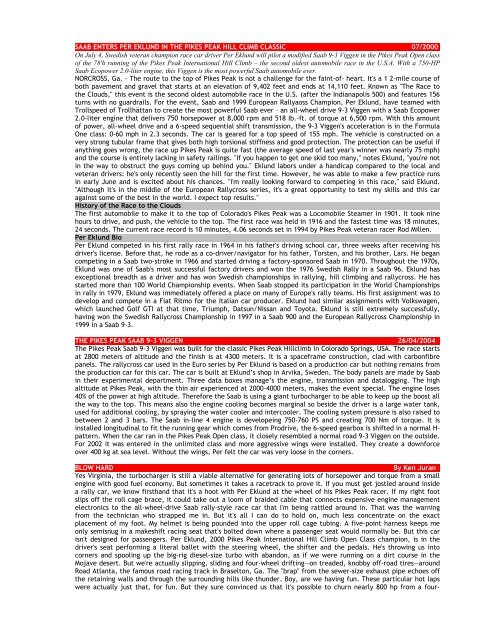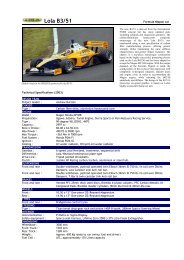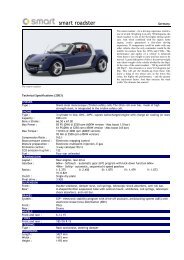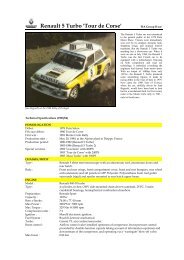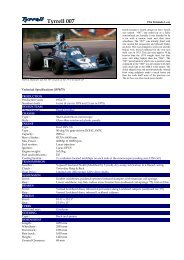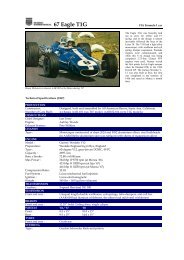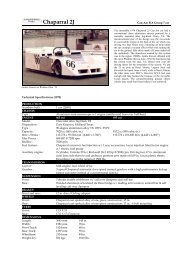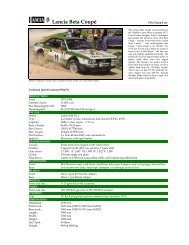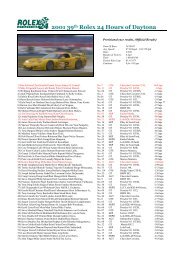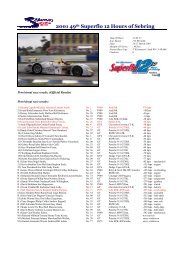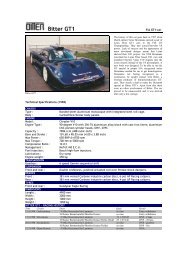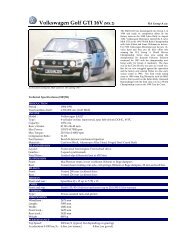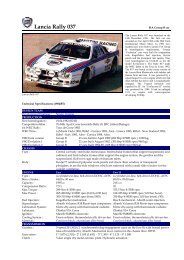Saab 9³ Viggen Pikes Peak - Motorsports Almanac
Saab 9³ Viggen Pikes Peak - Motorsports Almanac
Saab 9³ Viggen Pikes Peak - Motorsports Almanac
Create successful ePaper yourself
Turn your PDF publications into a flip-book with our unique Google optimized e-Paper software.
SAAB ENTERS PER EKLUND IN THE PIKES PEAK HILL CLIMB CLASSIC 07/2000<br />
On July 4, Swedish veteran champion race car driver Per Eklund will pilot a modified <strong>Saab</strong> 9-3 <strong>Viggen</strong> in the <strong>Pikes</strong> <strong>Peak</strong> Open class<br />
of the 78'h running of the <strong>Pikes</strong> <strong>Peak</strong> International Hill Climb – the second oldest automobile race in the U.S.A. With a 750-HP<br />
<strong>Saab</strong> Ecopower 2.0-liter engine, this <strong>Viggen</strong> is the most powerful <strong>Saab</strong> automobile ever.<br />
NORCROSS, Ga. - The route to the top of <strong>Pikes</strong> <strong>Peak</strong> is not a challenge for the faint-of- heart. It's a 1 2-mile course of<br />
both pavement and gravel that starts at an elevation of 9,402 feet and ends at 14,110 feet. Known as "The Race to<br />
the Clouds," this event is the second oldest automobile race in the U.S. (after the Indianapolis 500) and features 156<br />
turns with no guardrails. For the event, <strong>Saab</strong> and 1999 European Rallyaoss Champion, Per Eklund, have teamed with<br />
Trollspeed of Trollhättan to create the most powerful <strong>Saab</strong> ever – an all-wheel drive 9-3 <strong>Viggen</strong> with a <strong>Saab</strong> Ecopower<br />
2.0-liter engine that delivers 750 horsepower at 8,000 rpm and 518 Ib.-ft. of torque at 6,500 rpm. With this amount<br />
of power, all-wheel drive and a 6-speed sequential shift transmission, the 9-3 <strong>Viggen</strong>'s acceleration is in the Formula<br />
One class: 0-60 mph in 2.3 seconds. The car is geared for a top speed of 155 mph. The vehicle is constructed on a<br />
very strong tubular frame that gives both high torsional stiffness and good protection. The protection can be useful if<br />
anything goes wrong, the race up <strong>Pikes</strong> <strong>Peak</strong> is quite fast (the average speed of last year's winner was nearly 75 mph)<br />
and the course is entirely lacking in safety railings. "If you happen to get one skid too many," notes Eklund, "you're not<br />
in the way to obstruct the guys coming up behind you." Eklund labors under a handicap compared to the local and<br />
veteran drivers: he's only recently seen the hill for the first time. However, he was able to make a few practice runs<br />
in early June and is excited about his chances. "I'm really looking forward to competing in this race," said Eklund.<br />
"Although it's in the middle of the European Rallycross series, it's a great opportunity to test my skills and this car<br />
against some of the best in the world. I expect top results."<br />
History of the Race to the Clouds<br />
The first automobile to make it to the top of Colorado's <strong>Pikes</strong> <strong>Peak</strong> was a Locomobile Steamer in 1901. It took nine<br />
hours to drive, and push, the vehicle to the top. The first race was held in 1916 and the fastest time was 18 minutes,<br />
24 seconds. The current race record is 10 minutes, 4.06 seconds set in 1994 by <strong>Pikes</strong> <strong>Peak</strong> veteran racer Rod Millen.<br />
Per Eklund Bio<br />
Per Eklund competed in his first rally race in 1964 in his father's driving school car, three weeks after receiving his<br />
driver's license. Before that, he rode as a co-driver/navigator for his father, Torsten, and his brother, Lars. He began<br />
competing in a <strong>Saab</strong> two-stroke in 1966 and started driving a factory-sponsored <strong>Saab</strong> in 1970. Throughout the 1970s,<br />
Eklund was one of <strong>Saab</strong>'s most successful factory drivers and won the 1976 Swedish Rally in a <strong>Saab</strong> 96. Eklund has<br />
exceptional breadth as a driver and has won Swedish championships in rallying, hill climbing and rallycross. He has<br />
started more than 100 World Championship events. When <strong>Saab</strong> stopped its participation in the World Championships<br />
in rally in 1979, Eklund was immediately offered a place on many of Europe's rally teams. His first assignment was to<br />
develop and compete in a Fiat Ritmo for the Italian car producer. Eklund had similar assignments with Volkswagen,<br />
which launched Golf GTI at that time, Triumph, Datsun/Nissan and Toyota. Eklund is still extremely successfully,<br />
having won the Swedish Rallycross Championship in 1997 in a <strong>Saab</strong> 900 and the European Rallycross Championship in<br />
1999 in a <strong>Saab</strong> 9-3.<br />
THE PIKES PEAK SAAB 9-3 VIGGEN 26/04/2004<br />
The <strong>Pikes</strong> <strong>Peak</strong> <strong>Saab</strong> 9-3 <strong>Viggen</strong> was built for the classic <strong>Pikes</strong> <strong>Peak</strong> Hillclimb in Colorado Springs, USA. The race starts<br />
at 2800 meters of altitude and the finish is at 4300 meters. It is a spaceframe construction, clad with carbonfibre<br />
panels. The rallycross car used in the Euro series by Per Eklund is based on a production car but nothing remains from<br />
the production car for this car. The car is built at Eklund’s shop in Arvika, Sweden. The body panels are made by <strong>Saab</strong><br />
in their experimental department. Three data boxes manage’s the engine, transmission and datalogging. The high<br />
altitude at <strong>Pikes</strong> <strong>Peak</strong>, with the thin air experienced at 2000-4000 meters, makes the event special. The engine loses<br />
40% of the power at high altitude. Therefore the <strong>Saab</strong> is using a giant turbocharger to be able to keep up the boost all<br />
the way to the top. This means also the engine cooling becomes marginal so beside the driver is a large water tank,<br />
used for additional cooling, by spraying the water cooler and intercooler. The cooling system pressure is also raised to<br />
between 2 and 3 bars. The <strong>Saab</strong> in-line 4 engine is developeing 750-760 PS and creating 700 Nm of torque. It is<br />
installed longitudinal to fit the running gear which comes from Prodrive, the 6-speed gearbox is shifted in a normal Hpattern.<br />
When the car ran in the <strong>Pikes</strong> <strong>Peak</strong> Open class, it closely resembled a normal road 9-3 <strong>Viggen</strong> on the outside.<br />
For 2002 it was entered in the unlimited class and more aggressive wings were installed. They create a downforce<br />
over 400 kg at sea level. Without the wings, Per felt the car was very loose in the corners.<br />
BLOW HARD By Ken Juran<br />
Yes Virginia, the turbocharger is still a viable alternative for generating lots of horsepower and torque from a small<br />
engine with good fuel economy. But sometimes it takes a racetrack to prove it. If you must get jostled around inside<br />
a rally car, we know firsthand that it's a hoot with Per Eklund at the wheel of his <strong>Pikes</strong> <strong>Peak</strong> racer. If my right foot<br />
slips off the roll cage brace, it could take out a loom of braided cable that connects expensive engine management<br />
electronics to the all-wheel-drive <strong>Saab</strong> rally-style race car that I'm being rattled around in. That was the warning<br />
from the technician who strapped me in. But it's all I can do to hold on, much less concentrate on the exact<br />
placement of my foot. My helmet is being pounded into the upper roll cage tubing. A five-point harness keeps me<br />
only semisnug in a makeshift racing seat that's bolted down where a passenger seat would normally be. But this car<br />
isn't designed for passengers. Per Eklund, 2000 <strong>Pikes</strong> <strong>Peak</strong> International Hill Climb Open Class champion, is in the<br />
driver's seat performing a literal ballet with the steering wheel, the shifter and the pedals. He's throwing us into<br />
corners and spooling up the big-rig diesel-size turbo with abandon, as if we were running on a dirt course in the<br />
Mojave desert. But we're actually slipping, sliding and four-wheel drifting—on treaded, knobby off-road tires—around<br />
Road Atlanta, the famous road racing track in Braselton, Ga. The "brap" from the sewer-size exhaust pipe echoes off<br />
the retaining walls and through the surrounding hills like thunder. Boy, are we having fun. These particular hot laps<br />
were actually just that, for fun. But they sure convinced us that it's possible to churn nearly 800 hp from a four-


